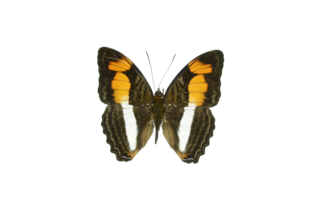
The Nymphalidae are the largest family of butterflies, with more than 6,000 species distributed throughout most of the world. Belonging to the superfamily Papilionoidea, they are usually medium-sized to large butterflies. Most species have a reduced pair of forelegs and many hold their colourful wings flat when resting. They are also called brush-footed butterflies or four-footed butterflies, because they are known to stand on only four legs while the other two are curled up; in some species, these forelegs have a brush-like set of hairs, which gives this family its other common name. Many species are brightly coloured and include popular species such as the emperors, monarch butterfly, admirals, tortoiseshells, and fritillaries. However, the under wings are, in contrast, often dull and in some species look remarkably like dead leaves, or are much paler, producing a cryptic effect that helps the butterflies blend into their surroundings.

Lorquin's admiral is a butterfly in the Nymphalinae subfamily. The butterfly is named after Pierre Joseph Michel Lorquin, a French naturalist who came to California from France during the Gold Rush, and made important discoveries on the natural history of the terrain.

The Limenitidinae are a subfamily of butterflies that includes the admirals and relatives. The common names of many species and genera reference military ranks or – namely the Adoliadini – titles of nobility, in reference to these butterflies' large size, bold patterns, and dashing flight. In particular, the light stripe running lengthwise across the wings of many Limenitidini has reminded earlier authors of officers' shoulder marks and epaulets.

Adelpha californica, the California sister, is a species of butterfly in the family Nymphalidae. They are common in California, but can also be found in western Nevada and Oregon, as well as in northern Baja California. The upper surfaces of their wings are dark brown to black with wide cream white bands dissecting both wings and two orange patches near the tips of the forewings. The underside is variously colored with browns, blue, orange, and white. A. californica is unpalatable to predators and is part of a large mimicry complex.
Butterfly evolution is the origin and diversification of butterflies through geologic time and over a large portion of the Earth's surface. The earliest known butterfly fossils are from the mid Eocene epoch, between 40-50 million years ago. Their development is closely linked to the evolution of flowering plants, since both adult butterflies and caterpillars feed on flowering plants. Of the 220,000 species of Lepidoptera, about 45,000 species are butterflies, which probably evolved from moths. Butterflies are found throughout the world, except in Antarctica, and are especially numerous in the tropics; they fall into eight different families.

Adelpha fessonia, the band-celled sister or Mexican sister, is a species of butterfly of the family Nymphalidae. It is found in Panama north through Central America to Mexico. It is a periodic resident in the lower Rio Grande Valley, Texas.

Adelpha is a genus of brush-footed butterflies found from the southern United States and Mexico to South America. They are commonly known as sisters, due to the white markings on their wings, which resemble a nun's habit. This genus is sometimes included with the admiral butterflies (Limenitis).

Adelpha syma, the Syma sister, is a species of butterfly of the family Nymphalidae. It is found in South America, including Paraguay, Argentina and Brazil.
A. californica may refer to:

Adelpha mesentina, the mesentina sister, is a species of butterfly of the family Nymphalidae. It is found in the eastern Andes from Venezuela to Bolivia and also on the Guiana Shield and throughout the central and western Amazon basin.

Adelpha melona, the Melona sister, is a species of butterfly of the family Nymphalidae. It is found in Central and South America.

Adelpha plesaure, the pleasure sister, is a species of butterfly of the family Nymphalidae.

Adelpha alala, the Alala sister, is a species of butterfly of the family Nymphalidae. It is found in South America.

Doxocopa pavon, the Pavon emperor or Pavon, is a species of butterfly in the family Nymphalidae. They can be found from Paraguay in South America up to Texas in the southern United States. They are generally brown in their overall coloration, with two bands of white straddling the middle of the upper surfaces of the wings, and a patch of orange on the tips of their forewings. The upper surfaces of the wings of the males are overlaid by an iridescent blue-purple sheen. The females of the species closely resemble members of the unrelated genus Adelpha.

Adelpha eulalia, the Arizona sister, is a species of butterfly in the family Nymphalidae. It occurs from at least Guatemala and Mexico to the southwestern United States, including southeastern California, Arizona, New Mexico, and southern Texas. They can also sometimes be found in Oklahoma, Kansas, Colorado, Utah, and Nevada.
Adelpha nea, the Nea sister, is a butterfly of the family Nymphalidae. It was described by William Chapman Hewitson in 1847. It is found from south-eastern Mexico, Belize and Costa Rica to Venezuela and southern Peru, the Guianas and Amazonian Brazil.

Adelpha erotia, the Erotia sister, is a butterfly of the family Nymphalidae. It was described by William Chapman Hewitson in 1847.

Adelpha cocala, the cocala sister or orange-washed sister, is a butterfly of the family Nymphalidae. It was described by Pieter Cramer in 1779. It is found from Honduras to Panama, Guatemala, Venezuela, Colombia, Surinam, Peru, Bolivia and Brazil.

Adelpha basiloides, the spot-celled sister, is a species of admirals, sisters in the family of butterflies known as Nymphalidae. It is found in North and Central America.















